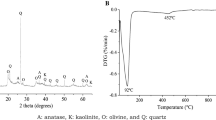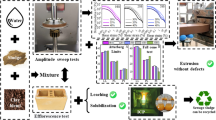Abstract
This study aims to evaluate the reuse of clayey quarry sludge generated during the washing process of aggregates in crushing plants as a raw material in ceramic bricks production. The representative sludge samples were collected from three quarries (S, G, and B) in Marrakesh region (Morocco). Different analytical techniques were used to investigate their mineralogical, chemical and physical properties. Ceramic pastes were elaborated using binary formulations based on the incorporation of each sludge at 0, 25%, 50%, 75%, and 100% with the conventional clay then sintered at 1050 °C. The mineralogical changes that take place during the incorporation of sludge were followed using XRD. The obtained results showed that the incorporation of sludge does not change the mineralogy of the fired bricks while the vitrification intensity increases. The sludge S and G can be used, at 100%, as an efficient substitute raw material, with a compressive strength of 20 MPa and flexural strength of 12 MPa. The optimal compressive and flexural strength were noticed to be about 36 MPa and 17 MPa, respectively, after the incorporation of 50% of sludge S. The total substitution by S and G as raw material in bricks manufacturing can contribute to the achievement of circular economy goals.
Graphical abstract











Similar content being viewed by others
References
Coronado ECM, Alonso NQR, Andrés SA (2019) Waelz slag—based construction ceramics: effect of the trial scale on technological and environmental properties. J Mater Cycles Waste Manag. https://doi.org/10.1007/s10163-019-00896-4
Singh SK, Rekha P, Surya M (2020) Utilization of Linz-Donawitz slag from steel industry for waste minimization. J Mater Cycles Waste Manag 22:611–627. https://doi.org/10.1007/s10163-020-00981-z
Taha Y, Benzaazoua M, Hakkou R, Mansori M (2017) Coal mine wastes recycling for coal recovery and eco-friendly bricks production. Miner Eng 107:123–138. https://doi.org/10.1016/J.MINENG.2016.09.001
Loutou M, Taha Y, Benzaazoua M et al (2019) Valorization of clay by-product from moroccan phosphate mines for the production of fired bricks. J Clean Prod 229:169–179. https://doi.org/10.1016/j.jclepro.2019.05.003
Taha Y, Benzaazoua M, Hakkou R, Mansori M (2016) Natural clay substitution by calamine processing wastes to manufacture fired bricks. J Clean Prod 135:847–858. https://doi.org/10.1016/j.jclepro.2016.06.200
Taha Y, Benzaazoua M, Mansori M, Hakkou R (2017) Recycling feasibility of glass wastes and calamine processing tailings in fired bricks making. Waste Biomass Valoriz 8:1479–1489. https://doi.org/10.1007/s12649-016-9657-3
Wang L, Sun H, Sun Z, Ma E (2016) New technology and application of brick making with coal fly ash. J Mater Cycles Waste Manag 18:763–770. https://doi.org/10.1007/s10163-015-0368-9
Xu H, Song W, Cao W et al (2017) Utilization of coal gangue for the production of brick. J Mater Cycles Waste Manag 19:1270–1278. https://doi.org/10.1007/s10163-016-0521-0
Du B, Zhou C, Duan N (2014) Recycling of electrolytic manganese solid waste in autoclaved bricks preparation in China. J Mater Cycles Waste Manag 16:258–269. https://doi.org/10.1007/s10163-013-0181-2
Quina MJ, Almeida MA, Santos R et al (2014) Compatibility analysis of municipal solid waste incineration residues and clay for producing lightweight aggregates. Appl Clay Sci 102:71–80. https://doi.org/10.1016/j.clay.2014.10.016
Hossain SS, Majhi LMMR (2018) Manufacturing of green building brick: recycling of waste for construction purpose. J Mater Cycles Waste Manag. https://doi.org/10.1007/s10163-018-0788-4
Ahmadi R, Souri B, Ebrahimi M (2020) Evaluation of wheat straw to insulate fired clay hollow bricks as a construction material. J Clean Prod 254:120043. https://doi.org/10.1016/j.jclepro.2020.120043
Ullah SMH, Hasan M, Ishtiaq S, Tanvir A (2020) Performance of industrial sludge—amended bricks manufactured in conventional kilns. J Mater Cycles Waste Manag. https://doi.org/10.1007/s10163-020-01080-9
Athira G, Bahurudeen A, Sahu PK et al (2020) Effective utilization of sugar industry waste in Indian construction sector: a geospatial approach. J Mater Cycles Waste Manag 22:724–736. https://doi.org/10.1007/s10163-019-00963-w
Luo DLH (2016) Characterizations of temperature effects on sintered ceramics manufactured with waste foundry sand and clay. J Mater Cycles Waste Manag. https://doi.org/10.1007/s10163-016-0553-5
Smol M, Kulczycka J, Henclik A et al (2015) The possible use of sewage sludge ash (SSA) in the construction industry as a way towards a circular economy. J Clean Prod 95:45–54. https://doi.org/10.1016/j.jclepro.2015.02.051
Girondi GD, Marvila MM, de Azevedo ARG et al (2020) Recycling potential of powdered cigarette waste in the development of ceramic materials. J Mater Cycles Waste Manag 22:1672–1681. https://doi.org/10.1007/s10163-020-01058-7
Martínez-García C, Eliche-Quesada D, Pérez-Villarejo L et al (2012) Sludge valorization from wastewater treatment plant to its application on the ceramic industry. J Environ Manage 95:S343–S348. https://doi.org/10.1016/j.jenvman.2011.06.016
Teixeira SR, Santos GTA, Souza AE et al (2011) The effect of incorporation of a Brazilian water treatment plant sludge on the properties of ceramic materials. Appl Clay Sci 53:561–565. https://doi.org/10.1016/j.clay.2011.05.004
Yaras A, Sutcu M, Gencel O, Erdogmus E (2019) Use of carbonation sludge in clay based building materials processing for eco-friendly, lightweight and thermal insulation. Constr Build Mater 224:57–65. https://doi.org/10.1016/j.conbuildmat.2019.07.080
Zhang M, Chen C, Mao L, Wu Q (2018) Use of electroplating sludge in production of fired clay bricks: Characterization and environmental risk evaluation. Constr Build Mater 159:27–36. https://doi.org/10.1016/j.conbuildmat.2017.10.130
Basegio T, Berutti F, Bernardes A, Bergmann CP (2002) Environmental and technical aspects of the utilisation of tannery sludge as a raw material for clay products. J Eur Ceram Soc 22:2251–2259. https://doi.org/10.1016/S0955-2219(02)00024-9
Herek LCS, Hori CE, Reis MHM et al (2012) Characterization of ceramic bricks incorporated with textile laundry sludge. Ceram Int 38:951–959. https://doi.org/10.1016/j.ceramint.2011.08.015
Vashistha P, Kumar V, Singh SK et al (2019) Valorization of paper mill lime sludge via application in building construction materials: a review. Constr Build Mater 211:371–382. https://doi.org/10.1016/J.CONBUILDMAT.2019.03.085
El-Mahllawy MS (2008) Characteristics of acid resisting bricks made from quarry residues and waste steel slag. Constr Build Mater 22:1887–1896. https://doi.org/10.1016/j.conbuildmat.2007.04.007
Galetakis M, Soultana A (2016) A review on the utilisation of quarry and ornamental stone industry fine by-products in the construction sector. Constr Build Mater 102:769–781. https://doi.org/10.1016/j.conbuildmat.2015.10.204
Medina G, Sáez del Bosque IF, Frías M et al (2018) Durability of new recycled granite quarry dust-bearing cements. Constr Build Mater 187:414–425. https://doi.org/10.1016/j.conbuildmat.2018.07.134
Loutou M, Hakkou R, Argane R et al (2018) Clayey quarry sludges: thermal transformation, microstructure and technological properties. Waste Biomass Valoriz 9:1805–1815. https://doi.org/10.1007/s12649-017-9972-3
Kahime K, Salem ABEN, Hidan AEL, Chakhchar A (2018) Vulnerability and adaptation strategies to climate change on water resources and agriculture in Morocco. Focus on Marrakech-Tensift-Al Haouz, pp 58–77
Ibnoussina M, Dimad A, El Amrani A et al (2016) Caractérisation des matériaux du sol dans la plaine du Haouz (Maroc), pour la construction en terre crue. J Mater Environ Sci 7:3623–3633
AFNOR (1992) NF P94—057—Analyse granulométrique des sols–méthode par sédimentation, p 20
Cook HE, Johnson PD, Matti JC, Zemmels I (1975) IV. Methods of sample preparation, and X-ray diffraction data analysis, X-ray mineralogy laboratory, Deep Sea Drilling Project, University of California, Riverside. Init Rep Deep Sea Drill Proj 25:999–1007
Boski T, Pessoa J, Pedro P et al (1998) Factors governing abundance of hydrolyzable amino acids in the sediments from the N.W. European Continental Margin (47–50°N). Prog Oceanogr 42:145–164. https://doi.org/10.1016/S0079-6611(98)00032-9
Heiri O, Lotter AF, Lemcke G (2001) Loss on ignition as a method for estimating organic and carbonate content in sediments: reproducibility and comparability of results. J Paleolimnol 25:101–110. https://doi.org/10.1023/A:1008119611481
El Boudour El Idrissi H (2017) Characterization of clays used in the earthenware sector of Marrakech region to improve the quality of the products. University of Cadi Ayyad (Morocco) and University of Liège (Belgium)
Cultrone G, Rodriguez-Navarro C, Sebastian E et al (2001) Carbonate and silicate phase reactions during ceramic firing. Eur J Mineral 13:621–634. https://doi.org/10.1127/0935-1221/2001/0013-0621
Bouachera R, Kasimi R, Ibnoussina M et al (2020) Reuse of sewage sludge and waste glass in the production of lightweight aggregates. Mater Today Proc. https://doi.org/10.1016/j.matpr.2020.08.410
Bernasconi A, Diella V, Pagani A et al (2011) The role of firing temperature, firing time and quartz grain size on phase-formation, thermal dilatation and water absorption in sanitary-ware vitreous bodies. J Eur Ceram Soc. https://doi.org/10.1016/j.jeurceramsoc.2011.02.006
El Ouahabi M, Daoudi L, Fagel N (2014) Preliminary mineralogical and geotechnical characterization of clays from Morocco: application to ceramic industry. Clay Miner 49:35–51
Bain JA (1979) Regional appraisal of clay resources—a challenge to the clay mineralogist. Dev Sedimentol 27:437–446. https://doi.org/10.1016/S0070-4571(08)70741-6
El IHEB, Daoudi L, El Ouahabi M et al (2016) Suitability of soils and river deposits from Marrakech for the manufacturing of earthenware. Appl Clay Sci 129:108–115. https://doi.org/10.1016/j.clay.2016.05.013
Cultrone G, Carrillo Rosua FJ (2020) Growth of metastable phases during brick firing: Mineralogical and microtextural changes induced by the composition of the raw material and the presence of additives. Appl Clay Sci 185:105419. https://doi.org/10.1016/J.CLAY.2019.105419
Hajjaji M, Mezouari H (2011) A calcareous clay from Tamesloht (Al Haouz, Morocco): properties and thermal transformations. Appl Clay Sci 51:507–510. https://doi.org/10.1016/j.clay.2011.01.018
Mahmoudi S, Bennour A, Srasra E, Zargouni F (2017) Characterization, firing behavior and ceramic application of clays from the Gabes region in South Tunisia. Appl Clay Sci 135:215–225. https://doi.org/10.1016/J.CLAY.2016.09.023
Cultrone G, Sebastián E, Elert K et al (2004) Influence of mineralogy and firing temperature on the porosity of bricks. J Eur Ceram Soc 24:547–564. https://doi.org/10.1016/S0955-2219(03)00249-8
Tabit K, Hajjou H, Waqif M, Saâdi L (2020) Effect of CaO/SiO2 ratio on phase transformation and properties of anorthite-based ceramics from coal fly ash and steel slag. Ceram Int 46:7550–7558. https://doi.org/10.1016/j.ceramint.2019.11.254
Loutou M, Hajjaji M (2017) Clayey wastes-based lightweight aggregates: Heating transformations and physical/mechanical properties. Appl Clay Sci 150:56–62. https://doi.org/10.1016/J.CLAY.2017.09.011
El Boudour El Idrissi H, Daoudi L, El Ouahabi M et al (2018) The influence of clay composition and lithology on the industrial potential of earthenware. Constr Build Mater 172:650–659. https://doi.org/10.1016/j.conbuildmat.2018.04.019
Sahbaz O, Üniversitesi D (2012) Physicochemical problems of mineral processing view project, p 48
Zhang J, Liu T, Huang Q et al (2020) Preparation, properties characterization and structure formation mechanism of silica sand tailings-based ceramic materials. Mater Chem Phys 255:123611. https://doi.org/10.1016/j.matchemphys.2020.123611
Acknowledgements
This research was conducted during an internship in Materials Sciences & Nano-Engineering department at Mohammed VI Polytechnic University, Ben Guerir, Morocco. This research was financially supported by National Centre of Scientific and Technical Research (CNRST, Morocco) under a grant number 10UCA2018. We are also thankful to the CENTRE OF NALYSIS AND CHARACTERIZATION (CAC) of Cadi Ayyad University, Morocco. The authors are grateful to Mr. Mustapha AIT ALI (L3G private Laboratory) for his technical input.
Author information
Authors and Affiliations
Contributions
RB conceptualization, methodology, validation, writing—original draft. RK supervision, writing—review and editing. MI supervision, writing—review and editing. MELA conceptualization, writing—original draft. YT conceptualization, writing—review and editing. HEBEI methodology, writing—review and editing. RH supervision, writing—review and editing.
Corresponding author
Ethics declarations
Conflict of interest
The authors declare that they have no known competing financial interests or personal relationships that could have appeared to influence the work reported in this paper.
Additional information
Publisher's Note
Springer Nature remains neutral with regard to jurisdictional claims in published maps and institutional affiliations.
Rights and permissions
About this article
Cite this article
Bouachera, R., Kasimi, R., Ibnoussina, M. et al. The clayey quarry sludge from a waste to a valuable raw material for red ceramics. J Mater Cycles Waste Manag 24, 1047–1058 (2022). https://doi.org/10.1007/s10163-022-01383-z
Received:
Accepted:
Published:
Issue Date:
DOI: https://doi.org/10.1007/s10163-022-01383-z




